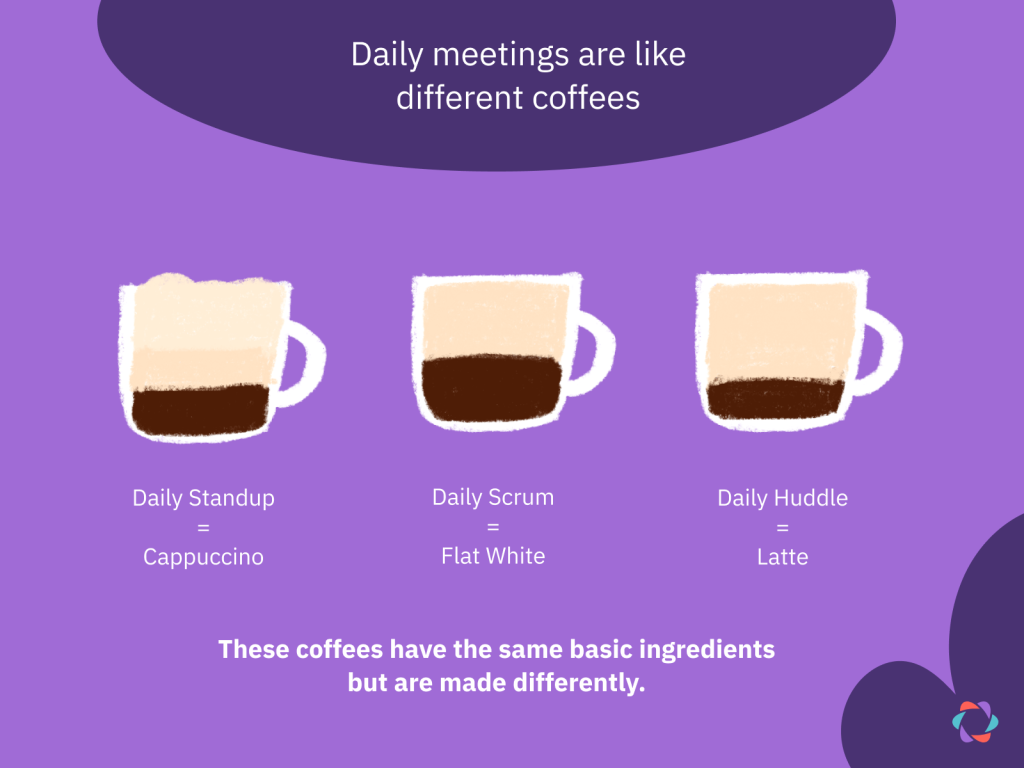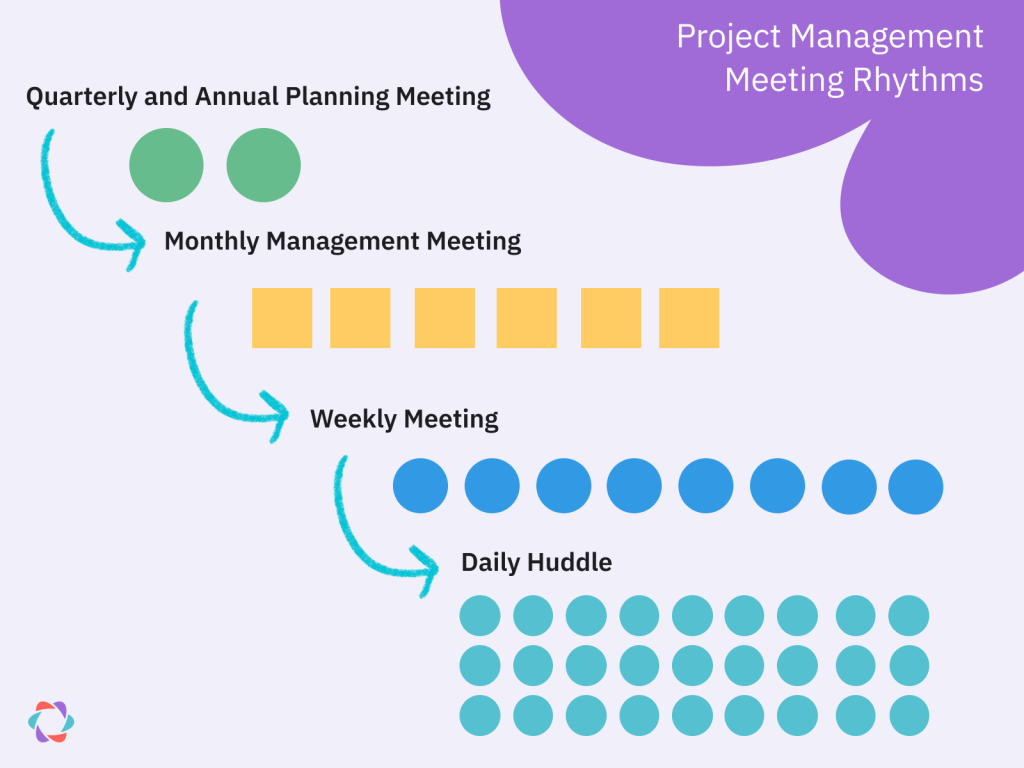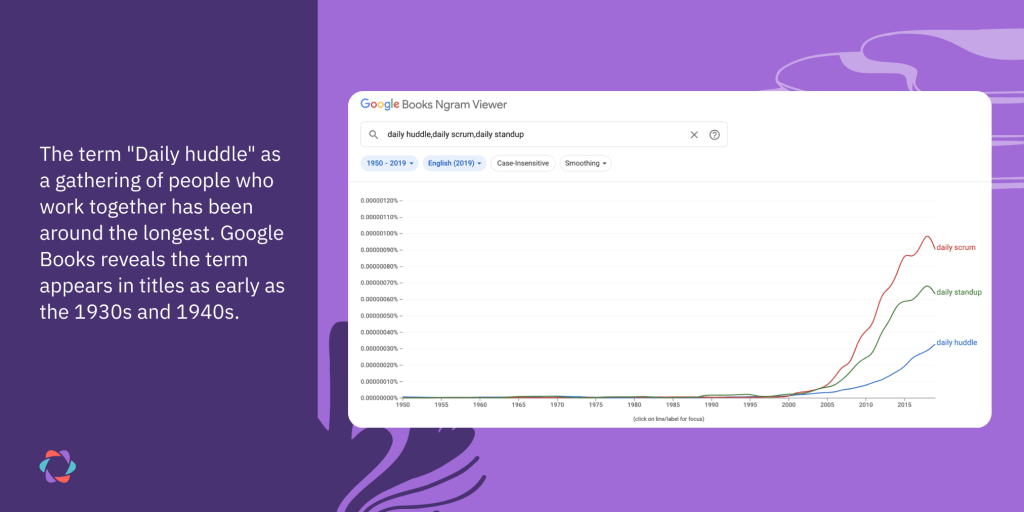Daily Huddle: Everything You Need For a Great Huddle Meeting

If the effort to hold an offsite strategy retreat is like making a complex frappuccino, you’d think a 15-minute daily huddle meeting would be a cup of tea.
But the daily huddle is more like a latte: often confused with other drinks like flat whites and cappuccinos.
Daily huddles, daily standups, and daily scrums are like cappucinos, flat whites, and lattes. They all have the same ingredients, but they’re made slightly differently!

In this article, we’ll help you get your huddles right by discussing:
- What is a daily huddle?
- What are the benefits of daily huddle meetings?
- What’s the difference between a daily huddle, daily standup, and Daily Scrum?
- Who attends the daily huddle?
- When should the daily huddle take place?
- Where should the daily huddle take place?
- Daily huddle agenda and questions
- Daily huddle tips
- Daily huddle tools
- Daily huddle templates
- Daily huddle FAQs
What is a daily huddle?
The daily huddle is a short meeting that teams or companies hold every day to sync up on their work. These gatherings don’t usually last more than 15 minutes and often take place face-to-face in person or over a call.
In most organizations, the huddle is a daily pulse check on the goals set in larger, less frequent meeting types.

Companies use huddle meetings to track the metrics and goals they’ve set in weekly, monthly, and quarterly meetings. Agile teams practicing Scrum use their daily events to check progress toward the Sprint Goal, an objective set during a periodic meeting called Sprint Planning.
What are the benefits of daily huddle meetings?
The main benefits of a daily huddle are that teams can:
- Track progress toward goals and metrics
- Create clarity, focus, and accountability for the day’s work
- Reduce ineffective and unnecessary internal communication over email and messengers
- Remove blockers quickly because people have a daily chance to bring them up
- Help team members bond with each other because people see and talk to each other at least once a day
What’s the difference between a daily huddle, daily standup, and Daily Scrum meeting?
The key differences between a daily huddle and a daily standup or Daily Scrum:
- Daily huddle: Practiced by all kinds of teams and companies. The least restricted reference to a daily meeting because it’s been around the longest with no official definition (though Mastering the Rockefeller Habits popularized and defined the term somewhat).
- Daily standup: Mostly practiced by agile teams and taking inspiration from XP, Scrum, and other daily meeting formats. This daily standup meeting has established practices but no ironclad rules.
- Daily Scrum: Practiced by Scrum teams and the most restricted variation because the term is officially defined and prescribed with dos and don’ts in the Scrum Guide.
The practice of holding a team meeting on a daily basis is often attributed to John D. Rockefeller (for example, in Mastering the Rockefeller Habits by Verne Harnish). Rockerfeller would have lunch every workday with the leaders of his company, Standard Oil.
Fast forward to the 21st century, and this practice is best known as the “Daily Scrum” meeting with “daily standup” a close second and “daily huddle” trailing behind.
Most people use these terms interchangeably, and there’s no international daily meeting tribunal to say whether that’s okay or not.
What does the data say about daily meetings?
All three terms took off in popularity around the start of the 21st century, with “Daily Scrum” quickly overtaking the others as it is the official definition used in Scrum – currently the world’s most popular agile framework.

- The term “Daily huddle” as a gathering of people who work together has been around the longest. Google Books reveals the term appears in titles as early as the 1930s and 1940s.
- “Daily standup” appears in the 1960s, especially in books about aviation and military teams.
- Later, in the 1990s, the term “daily standup” was used in another agile framework – Extreme Programming (XP).
Daily huddle meeting logistics
Because of its daily occurrence, preparing your meeting shouldn’t take much time. But once it starts, you and your team must be clear about what you do during the meeting.
Who attends the daily huddle?
There’s no golden rule for who attends your daily meeting. Usually, you plan the meeting for teams that collaborate closely with a common goal – say, a team of software developers working on a product.
But it can also be an executive team or even front-line employees in a hotel.
There’s also no official limit on the number of people who can attend. Generally, less is more when deciding who to invite. But don’t let that adage stop you from adding attendees if that seems helpful. The Ritz-Carlton, for example, has 80 people in their huddle at headquarters, according to the book Scaling Up.
When should the daily huddle take place?
You should schedule your daily huddle at the same time and place every day, for the sake of simplicity. Many companies hold morning huddles before starting work. That timing nudges everyone to come up with a clear focus for the day and ensures the team can solve any pending issues immediately.
Other times are acceptable, too, though. It’s worth experimenting with what works best for your team. A pre-lunch slot, for example, fits with a natural break in the day. The prospect of lunch also gives everyone another reason to keep the meeting short.
“Make on-time attendance mandatory, with no excuses! I’ve been in intense meetings with clients. I’ve been in the midst of seeking funds from venture capitalists. It doesn’t matter; I tell them I need to take a break for my daily meeting. And it only gains me respect.”
Verne Harnish in Mastering the Rockefeller Habits
Where should the daily huddle take place?
Co-located groups can meet in a central location that’s close to where everyone works. Remote teams can hold a real-time conference call or Zoom meeting. Teams can also opt for a free online meeting tool like Parabol’s to create an asynchronous version of their daily meeting.
Asynchronous huddles allow everyone to contribute their update in their own time. This method works particularly well for distributed teams where team members in China, for example, are ending their days as team members in the U.S. are waking up.
Daily huddle agenda and questions
Most teams follow a simple agenda of three questions that are asked of each attendee (or of each project or team leader for larger meetings).
Some add more agenda items, but that makes it harder to keep the huddle short.
Most groups time these questions and agenda items – five minutes per question or roughly 60 seconds per attendee to answer all three.
Ask three questions
Since you want the meeting to become a routine that doesn’t need much planning, having a predefined set of daily huddle questions is a practical and common format.
Here are two typical question sets. Both aim to create focus for the coming day’s work, remove blockers, and get a quick pulse check on completed work or KPIs.
Daily huddle questions from Mastering the Rockefeller Habits and Scaling Up:
- What’s up (in the next 24 hours)?
- What are the daily metrics?
- Where are you stuck?
Daily huddle questions borrowed from the Daily Scrum:
- What did you do yesterday?
- What will you do today?
- Are there any blockers or impediments preventing you from doing your work?
Want more agenda inspiration? Check out our list of 57 daily huddle questions to try out with your team or our 14 daily standup formats.
Consider other agenda items
Here are some other topics you may want to cover in your Daily Huddle agenda:
- 🥳 Good news: Let people share a piece of good news to start the meeting and get everyone in a positive mood to boost motivation.
- 👋 Company or people updates: Important information about anything that happened within the business over the past 24 hours (e.g., a team member resigned or got hired or a lawsuit was filed against the company).
- ⚙️ Issues and improvements: Share a problem or idea for process improvement within the organization that’s not within your control to fix. The goal is not to discuss or fix those suggestions on the spot but to place them in a log you can deal with later, for example, during a lessons learned meeting.
- 🙋♂️Quick questions: Provide a dedicated space for people to ask questions that don’t fit within any other prompts or sections.
- 🧮 Metrics: For sales or service staff, statistics such as customer satisfaction or sales numbers can help ground teams before starting their days and give them a target to work towards.
Tips, templates, and tools for better daily meetings
You can improve and ease your huddle process with these tips, tools, and templates.
Daily huddle tips
Here are six tips and best practices for running your daily huddles:
- ✨ Keep the agenda light. Cut some questions or items from your huddle’s agenda if it frequently passes 15 minutes. Since the gathering happens daily, it becomes a burden when it regularly runs over time.
- 🥸 Get straight to business, maybe. Another way to stay within the 15-minute timebox of the meeting is to skip niceties and formalities. No how are you’s or personal updates – get straight to business instead. Whether this approach suits you largely depends on your company’s culture and the personalities of your team members.
- 🔮 Look forward, not backward. You mostly want to talk about what’s ahead instead of getting status updates on things that have already happened. As Verne Harnish writes in his books, “Looking forward is great management; looking backward is micromanagement.”
- 🔎 Find problems, don’t solve them. The meeting is for identifying and highlighting issues. Solving those problems can happen afterward as they usually need more than 15 minutes and fewer than all the huddle’s attendees.
- 🪑 Try both standing up and sitting down. Having all participants stand during the meeting helps some teams keep the meeting short. Others actually find their daily gatherings improve when they’re comfortably seated. Experiment and find out what works best for your team.
- ♻️ Mix up the format. Having the same agenda every time risks the meeting becoming too much of a routine, with people falling back on boilerplate answers. To avoid such dullness, mix up your format on a weekly or monthly basis.
Daily huddle tools
Your daily huddles can benefit from two tools:
- A task or progress board
- An online daily tool like Parabol
A virtual or physical task board allows attendees and other stakeholders to track and reference the information they share during the meeting. This may include fixed tasks and their status, or things like metrics.
A typical format is a grid with the days of the week and the three huddle questions. Agile teams often gather in front of their existing task board.
Parabol’s tool for asynchronous daily huddles
Remote teams can run their huddles asynchronously with Parabol’s online meeting tool. This is a great option is your team are distributed across time-zones or in different physical locations.
Async daily huddles have several benefits:
- 🌙 Nobody has to join the meeting at odd hours.
- 🕦️ Each team member can contribute at a time that best suits their life and workflow.
- 🤗 Input is more inclusive since introverts don’t have to fear speaking in front of a group or being put on the spot by peers.
- 🔍️ Information becomes searchable and referenceable since everything is written down instead of spoken.
Parabol’s async standup displays everyone’s update in one grid view, so it’s easy to see what others are sharing. Changing the day’s prompt is also straightforward, so you can keep your huddles fresh and engaging.

Daily huddle agenda templates
There are countless ways you can structure your daily meeting. How you do it depends on your daily goals and metrics. But here are some alternative formats we like:
Daily huddle FAQs
To wrap up, here are answers to two frequently asked questions about the daily huddle.
What’s the meaning of a daily huddle?
The daily huddle is a short meeting teams or companies hold every day to sync up on their work. These gatherings usually don’t last more than 15 minutes and take place face-to-face in person or over a call.
The practice originates from John D. Rockefeller, who held a daily lunch with the leaders of his company, Standard Oil.
The term “huddle” comes from sports, where teams often gather together before a match for a final motivating word or to review tactics with each other.
Can people have more than one daily huddle?
Most team members should have only one daily huddle. Some managers and executives might have two: one with their team and one with their peers or boss.
In that case, it’s helpful for the regular team meetings to happen first and the executive or management huddle afterward. Managers then have the information they need to report and act on in that second gathering.
Run your next daily huddle in Parabol
Take the stress out of organizing your daily huddle by letting Parabol do the hard work. Parabol is free for up to two teams and lets you run effective and inclusive asynchronous daily meetings.
If you’re a remote team or have colleagues in other countries and time-zones, Parabol is the easiest way to run your next daily meeting.
Try it for free today.
💡 Check out our Daily standup hub for an overview of all our resources on daily standups.






